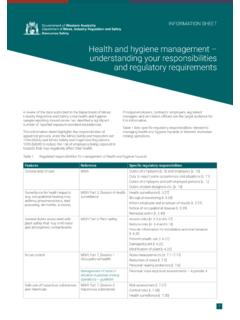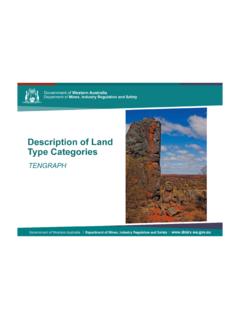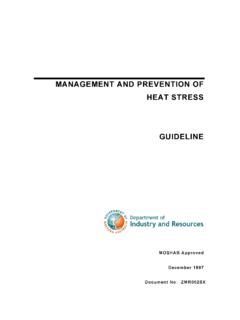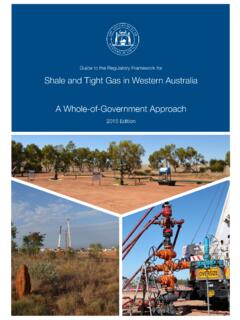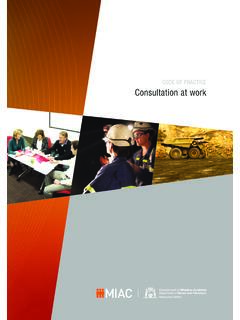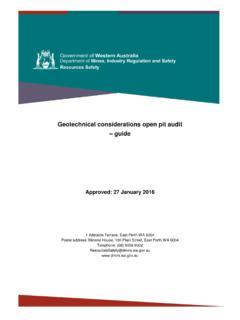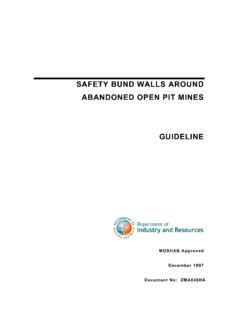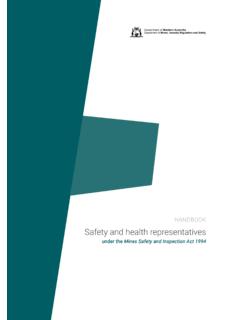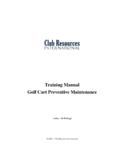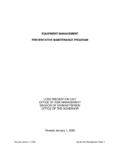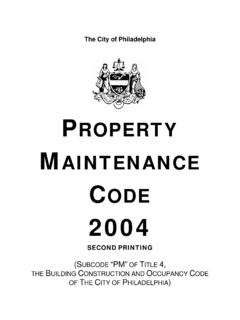Transcription of Tailings storage facilities in Western Australia - …
1 CODE OF PRACTICET ailings storage facilities in Western AustraliaCODE OF PRACTICET ailings storage facilities in Western AustraliaIIDisclaimerThe information contained in this publication is provided in good faith and is believed to be reliable and accurate at the time of publication. However, the information is provided on the basis that the reader will be solely responsible for assessing the information and its veracity and State shall in no way be liable, in negligence or howsoever, for any loss sustained or incurred by anyone relying on the information, even if such information is or turns out to be wrong, incomplete, out-of-date or this disclaimer:State means the State of Western Australia and includes every Minister, agent, agency, department, statutory body corporate and instrumentality thereof and each employee or agent of any of includes information, data, representations, advice, statements and opinions, expressly or implied set out in this includes loss, damage, liability, cost, expense, illness and injury (including death).
2 ReferenceDepartment of Mines and Petroleum, 2013, Tailings storage facilities in Western Australia code of practice: Resources Safety and Environment Divisions, Department of Mines and Petroleum, Western Australia , 13 978 1 922149 02 2 Department of Mines and Petroleum 2013 Except where the Copyright Act otherwise allows, reproduction in whole or part of this publication will be permitted only with the prior written permission of the Department of Mines and Petroleum. Applications for permission should be addressed to the Manager Safety Communications, Resources publication is available on request in other formats for people with special publication is also available in digital format (PDF) online at details of publications produced by Resources Safety can be obtained by contacting:Resources Safety Department of Mines and Petroleum 100 Plain Street EAST PERTH WA 6004 Telephone: + 61 8 9358 8002 (general queries) + 61 8 9358 8154 (publication orders)NRS: 13 36 77 Facsimile: + 61 8 9358 8000 Email.
3 (general queries) (publication orders)ForewordBasis for code of practiceThis code of practice is issued by the Department of Mines and Petroleum under the Mines Safety and Inspection Act 1994 and the Mining Act 1978, with the endorsement of the Mining Industry Advisory Committee (MIAC) and approval from the Minister for Mines and code of practice is a guide to achieving the standards required under legislation. It applies to anyone who has a duty of care or responsibility in the circumstances described in the code. In most cases, following a code of practice would achieve compliance with the duties or requirements under the legislation in relation to the subject matter of the code.
4 However, like regulations, codes of practice deal with particular issues and do not cover all situations that may arise. Codes of practice are admissible in court proceedings. Courts may regard a code of practice as evidence of what is known about a hazard, risk or control and may rely on the code in determining what is reasonably practicable in the circumstances to which the code with the legislation may be achieved by following another method, such as a technical or an industry standard, if it provides an equivalent or higher standard of work health and safety than the inspector may refer to an approved code of practice when issuing an improvement or prohibition notice. Scope and applicationThis Code will assist those involved with Tailings storage facilities (TSFs) to meet their legislative obligations for work health and safety under the Mines Safety and Inspection Act 1994 and environmental matters under the Mining Act storage facilities are reservoirs that store mine Tailings , which is waste material discharged from an ore processing plant or coal preparation plant.
5 A TSF includes pits, dams, ponds, integrated waste landforms, erosion protection bunds, levee banks, diversion channels, spillways and seepage collection trenches associated with the storage of code does not apply to waste rock landforms ( waste dumps), heap or vat leaching facilities , flood protection bunding, surface water diversions, or underground mine fill using to the varying nature of potential hazards and control measures when managing TSFs, this Code has been prepared as a performance-based standard that states the outcome to be achieved rather than providing a detailed prescriptive methodology for achieving the outcome. In line with a performance-based approach, this Code focuses on the factors to be considered rather than specific control measures.
6 However, more detailed guidance is available from the Departmental website to assist with the submission of: mining proposals design report project management plans prior to construction construction reports operating manual periodic environmental reports periodic audit reports decommissioning plans radiation management plansinvolving TSFs, as required by the tenement conditions applied under the Mining Act 1978, and requirements of the Mines Safety and Inspection Act should use this code?You should use this code if you have functions and responsibilities for site selection, design, construction, operation, monitoring and surveillance, emergency response planning, management or rehabilitation of TSFs. The code may also be useful for supervisors, TSF personnel, and safety and health representatives who need to understand the hazards and environmental requirements associated with constructing, operating and decommissioning to use this code of practiceThe code includes references to both mandatory and non-mandatory words must or requires indicate that legal requirements exist, which must be complied with.
7 The word should indicates a recommended course of ..IIIC hapter 1 Introduction .. Aims .. Structure of code .. Roles of competent persons ..1 Chapter 2 Classification .. Introduction .. Hazard ratings .. TSF categories ..4 Chapter 3 Site selection ..5 Chapter 4 Design .. Design needs .. Design factors .. Design submission ..6 Chapter 5 Construction .. Construction Construction report submission ..7 Chapter 6 Operation .. Operation and maintenance manual .. Operational record .. Operational review ..8 Chapter 7 Emergency preparedness and planning ..9 Chapter 8 Closure .. Planning for closure .. Decommissioning review ..10 Chapter 9 Information, instruction, training and supervision .. Introduction .. Information .. Instruction.
8 Training .. Supervision ..11 Appendix 1 Resources and useful storage facilities in Western Australia CODE OF PRACTICEVIT ailings storage facilities in Western Australia CODE OF PRACTICE11 AimsThe aims of this code of practice are to describe: a set of outcomes for Tailings storage facilities (TSFs) to meet the approval requirements of the project management plan under the Mines Safety and Inspection Act 1994 and Mines Safety and Inspections Regulations 1995, the mining proposal under the Mining Act 1978 and Mining Regulations 1981, and the review report under tenement conditions the variables to be considered to demonstrate that a TSF is safe, stable, erosion-resistant and non-polluting the role of the competent person in the hazard management process for TSFs the broader occupational health and safety requirements for operating in accordance with the Mines Safety and Inspection Act 1994 and Mines Safety and Inspection Regulations code promotes a proactive approach to monitoring and surveillance during construction, operation.
9 And prior to decommissioning so it is possible to predict a TSF s long-term performance and potential environmental impact after a tenement is Structure of codeChapter 2 describes the hazards-based approach to categorising TSFs in Western Australia . The level of TSF management needs to be commensurate with the potential impacts of TSF loss of integrity or failure during operation and decommissioning, and after tenement 3 to 8 are structured to support a hazard management approach that follows the life cycle of a TSF, including: site selection design construction operation emergency planning decommissioning planning and rehabilitation decommissioning monitoring and 9 summarises the requirements for information, instruction, training and supervision to ensure the integrity of the TSF and occupational safety and health of affected resources and useful links are listed in Appendix Roles of competent personsTo assure a safe, stable, erosion-resistant and non-polluting TSF at the end of the life cycle, competent persons should.
10 Select an appropriate site certify the design certify that construction meets design specifications and tolerances ensure performance is within operational tolerances provide training and assess the competency of TSF personnel conduct monitoring and surveillance conduct reviews and prepare : A competent person is considered to be someone who is appointed or designated by the employer or tenement holder to perform specified duties that the person is qualified to perform by knowledge, training and storage facilities in Western Australia CODE OF PRACTICE22 IntroductionThe primary function of a TSF is the safe and economical storage of Tailings in an erosion-resistant, non-polluting structure that minimises environmental need to be individually tailored to the site, ore mineralogy, plant process and desired long-term landform and, therefore, will have a variety of designs and construction techniques.
